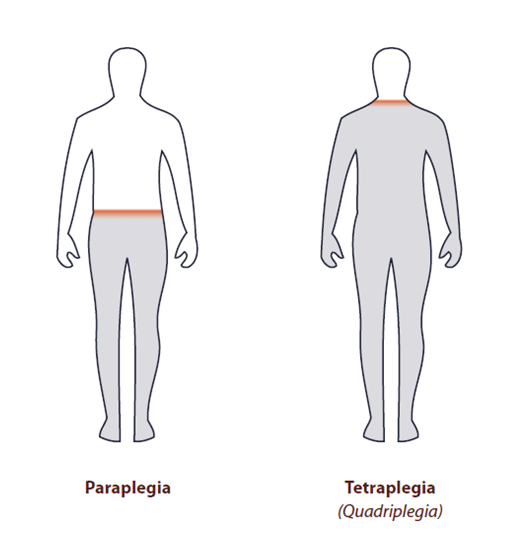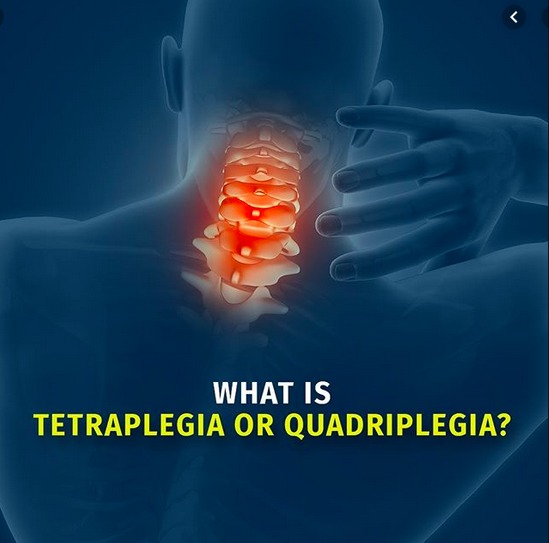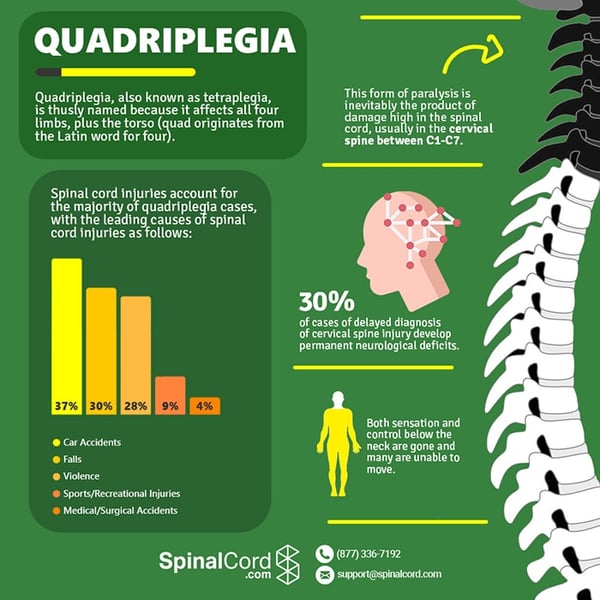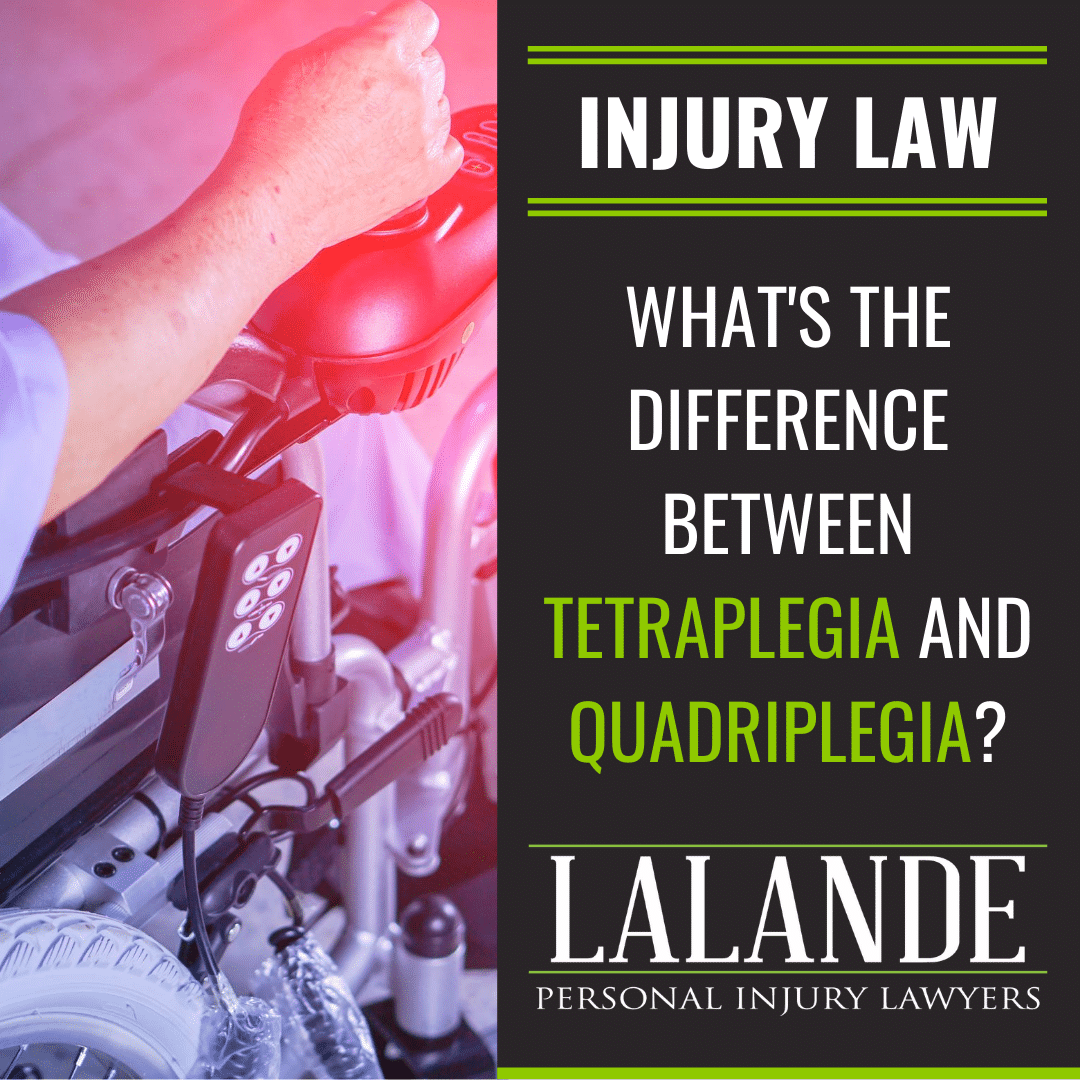
Paraplegia and Tetraplegia (Quadriplegia) How family members can help
Tetraplegia is a paralysis caused by an injury of the cervical spinal cord. This can result in a partial or total sensory and motor loss of the four limbs and torso[1]. The injuries that occur above level C4 often result in respiratory deficiency.[2]

Quadriplegia and Paraplegia Information and Infographic Medical
Tetraplegia and quadriplegia are actually the same thing. The reason for the difference in terminology is because of the prefixes—both "tetra" and "quadri" mean "four" in Greek and Latin, respectively. Regardless of which term you prefer, this type of spinal cord injury is so named because it affects all four limbs—the arms and.

What is tetraplegia and is it different from quadriplegia?
The words "quadriplegia" and "tetraplegia" mean the same thing: paralysis below the neck that affects all of a person's limbs. The reason that there are two terms with the same meaning is because of differences in ancient languages. There are three ancient root words from two different languages involved in these terms:

Pin on Spinal cord injury
Tetraplegia is a type of paralysis that results in the loss of movement and sensation in all four limbs. It affects different parts of the body depending on the person. It mostly affects the.

What Damages Am I Entitled to If I Suffer Paralysis as the Result of an
Tetraplegia (formerly called quadriplegia) generally describes the condition of a person with an SCI that is at a level anywhere from the C1 vertebra down to the T1. These individuals can experience a loss of sensation, function, or movement in their head, neck, shoulders, arms, hands, upper chest, pelvic organs, and legs.

Paraplegia Injury Spinal cord injury nursing, Spinal cord injury
Quadriplegia, also known as tetraplegia, is a form of paralysis that affects all four limbs, plus the torso ("quad" originates from the Latin word for four). Most people with tetraplegia have significant paralysis below the neck, and many are completely unable to move.

Quadriplegia or tetraplegia occurs when paralysis or weakness affects
Paraplegia is a specific pattern of paralysis (which is when you can't deliberately control or move your muscles) that affects your legs. This happens because of a problem with your nervous system. Depending on how it happens, this paralysis may have different effects on some body systems or processes.
.jpg?width=600&name=Quadriplegia Paraplegia Definition (1).jpg)
What is Tetraplegia, Quadriplegia and Paraplegia?
A loss of motor function can present as either weakness or paralysis leading to partial or total loss of function in the arms, legs, trunk, and pelvis; paraplegia is similar but affects the thoracic, lumbar, and sacral segments of the spinal cord and arm function is retained. [1] The paralysis may be flaccid or spastic. [2]

Pin on 神经病学
Quadriplegia is the condition in which both the arms and legs are paralyzed and lose normal motor function. Also referred to as tetraplegia, this diagnosis is actually a symptom of one of several unique underlying causes.

Spinal cord injury Symptoms and causes Auxiliar de enfermeria
An injury higher on the spinal cord can cause paralysis in most of the body and affect all limbs (tetraplegia or quadriplegia). An injury that occurs lower down the spinal cord may only affect a person's lower body and legs (paraplegia).

tetraplegia & paraplegia Spinal cord injury awareness, Spinal cord
Tetraplegia may be better known as quadriplegia, a condition in which the arms and legs are paralyzed. The condition is usually the result of an injury, rather than an illness or a congenital.

Quadriplegia & Tetraplegia Definition, Causes, Symptoms, and Treatment
Paraplegia is a type of paralysis that affects the lower half of the body. We explain how paraplegia is diagnosed, symptoms, treatment, and more.. Quadriplegia. This type impacts both arms and.

What is Tetraplegia, Quadriplegia and Paraplegia?
When all four limbs are affected, this is called tetraplegia or quadriplegia. Requires complete assistance with activities of daily living, such as eating, dressing, bathing, and getting in or out of bed May be able to use powered wheelchairs with special controls to move around on their own Will not be able to drive a car on their own

What’s the Difference Between Tetraplegia and Quadriplegia? Lalande
Lower thoracic lesions can cause paraplegia while lesions at cervical level are associated with quadriplegia . SCI typically affects the cervical level of the spinal cord (50%). patients who suffered SCI between 1955 and 2006 in Australia demonstrated that survival rates for those suffering from tetraplegia and paraplegia is 91.2 and 95.9%.

Quadriplegia Explained! Insight To The Life Of The Quadriplegics
There are many different causes of paralysis—and each one may result in a different kind of paralysis, such as quadriplegia (paralysis of arms and legs), paraplegia (being paralyzed from the waist down), monoplegia (paralysis in one limb), or hemiplegia (being paralyzed on one side of the body).

MEDICAL SCHOOL paraplegia and tetraplegia,what to know? Paraplegia
Paraplegia is the result of a severe spinal cord injury below the first thoracic spinal level, from the spinal segments T1-L5. Individuals who are categorized as paraplegic still have full use of their arms and hands, but they may have full loss or partial loss of the ability to use their legs.
